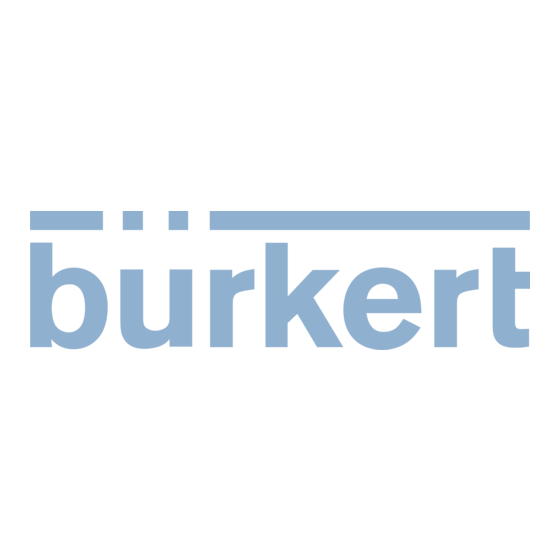
Table of Contents
Advertisement
Quick Links
Design:
2-way solenoid valve, direct acting, normally closed (Circuit
function A) or normally open (Circuit function B).
Seal Materials and Fluids handled:
See Table.
Fluid and Ambient Temperature:
For Hazardous Locations Div. 1 (T4 rated)
Max. Ambient Temperature
Max. Fluid Temperature
The UL-listed valve for Hazardous Locations is suitable for
the fluids air, inert gas, water and gasoline.
For Hazardous Locations Div. 1 (T6 rated)
Max. Ambient Temperature
Max. Fluid Temperature
For Hazardous Locations Div. 2 and Ordinary Locations:
See Table.
Pressure Range:
Maximum inlet pressure see label on valve.
Installation:
Before installing valve ensure that piping etc. is free of foreign
matter (metal fillings, seal materials, welding scale etc.). In-
stallation as required but preferably with coil uppermost. Instal-
lation in this position tends to prevent foreign matter remaining
in core tube (increased life). Do not put any loads on coil unit.
Type 0211: PTFE tape is recommended for sealing ports. Arrow
on valve body indicates flow direction. Mounting is accomplished
by means of four M4 x 8 mm tapped holes located on the valve
underside.
Type 0212: Outlet port is coded on side of body. For common
pressure, align "A" marking on valve and manifold. To remove
valve from manifold loosen only the two unsealed screws.
Manifolds can be connected togehter with nipples.
Tempera-
Fluid
tures [° F]
Fluid T.
Air
Ambient
Fluid T.
Water
Ambient
Fluid T.
Neutral Gas
Ambient
Fluid T.
Light oil
Ambient
Fluid T.
LP-gas
Ambient
Fluid T.
Refrigerants
Ambient
Operating Instructions
104 °F (40 °C)
194 °F (90 °C)
104 °F (40 °C)
140 °F (60 °C)
Seal Materials
Buna „N‰
Ethylene
Propylene
+14 to +194
-40 to +266
+14 to +130
+14 to +130
+32 to +194
+32 to +212
+32 to +130
+32 to +130
+14 to +194
-40 to +266
+14 to +130
+14 to +130
+14 to +194
+14 to +130
+14 to +140
+14 to +130
Approvals
The valve is either approved as
General Purpose valve for Hazardous Locations
Class I, Division 1, Group A, B, C, D
Class II, Division 1, Group E, F, G
Class III, Division 1 and 2
Operating Temperature T 4
or
General Purpose valve for Hazardous Locations
Class I, Division 1, Group A, B, C, D
Class II, Division 1, Group E, F, G
Class III, Division 1 and 2
Operating Temperature T 6
or
FM approved as
Nonincendive for Hazardous Locations
Class I, Division 2, Group A, B, C, D
Class II, Division 2, Group F, G
Class III, Division 1 and 2
Operating Temperature T 4
UL listed for Ordinary locations
CSA approved for Ordinary locations
See label on the valve.
Marking (example):
Circuit function
A
=
Normally Closed
B
=
Normally Open
Seal Material
EPDM
=
NBR
=
FKM
=
EA
=
EF
=
NN
=
Body Material
BR
=
SS
=
NI
=
PL
=
Maximum Pressure
Voltage / Frequency / Power Consumption
Recorder No.
Seat / O-ring
PTFE/
FKM
Ethylene
Propyl.
+14 to +266
+14 to +266
+14 to +130
+14 to +130
+32 to +212
+32 to +212
+32 to +130
+32 to +130
+14 to +266
+14 to +266
+14 to +130
+14 to +130
+14 to +266
+14 to +130
+14 to +140
+14 to +130
Type 0211/0212
EPDM
NBR
FKM
PTFE seat and EPDM O-ring
PTFE seat and FKM O-ring
Neoprene
Brass
Stainless Steel
Nickel Plated Brass
Polyamide Plastic
PTFE/
Neoprene
FKM
+14 to +266
+14 to +130
+32 to +212
+32 to +130
+14 to +266
+14 to +130
+14 to +266
+14 to +130
+14 to +140
+14 to +130
+14 to +194
+14 to +130
Advertisement
Table of Contents

Summary of Contents for Burkert 0211
- Page 1 (increased life). Do not put any loads on coil unit. Marking (example): Type 0211: PTFE tape is recommended for sealing ports. Arrow on valve body indicates flow direction. Mounting is accomplished Circuit function...
- Page 2 Sales Center Chr.-Bürkert-Str. 13-17 D-74653 Ingelfingen Tel. + 49 (0) 7940 - 10 91 111 Fax + 49 (0) 7940 - 10 91 448 E-mail: info@de.buerkert.com International Contact addresses can be found on the Internet at: www.burkert.com Bürkert Company Locations...















Need help?
Do you have a question about the 0211 and is the answer not in the manual?
Questions and answers